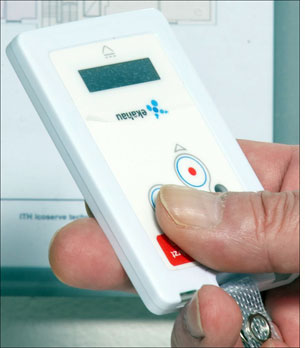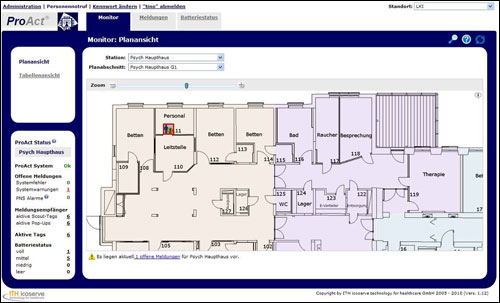Nov 01, 2010Austria's University Hospital in Innsbruck has installed two RFID-based alarm systems to track workers at its facility who may be confronted with aggressive patients. One system is used by emergency-room employees who deal with potentially dangerous situations, such as those involving drunken individuals who come to the hospital for care, while the other is intended for attendants at the psychiatric ward. Both deployments depend on Ekahau's Wi-Fi-enabled battery-powered RFID tags and real-time location system (RTLS) software.
The emergency-room system, which was rolled out in September of this year, outfits roughly 50 employees with Ekahau's Wi-Fi-based T301BD badge RFID tags, which they carry in their pockets. A caregiver concerned for his or her safety can press a button on the palm-size device, and the system will locate that worker within the building and notify colleagues also carrying the device to come to his or her assistance. The employee knows the help signal was sent upon hearing a beep.
All who work within the same ward and carry the device also hear a beep once the alarm is received, and are required to respond by pushing a button on their own devices, and by coming to their co-worker's aid. They receive a text message detailing the location of the colleague in need of help, along with a time stamp indicating when the alarm was activated. The system's designers labeled zones within the hospital to describe the origin of the alarm. For instance, the text message may indicate that the individual requiring help is located on the second floor in the southern zone.
Workers sitting at select PCs also receive each alarm signal, as well as a map of the ward's layout on their screen. The map illustrates where the incident was reported, and also informs workers that a colleague is in need of help. Further details, such as a history of the alarms sent from the same device, are available to supervisors at different computers.
"Due to severe legal restrictions and challenging reservations regarding privacy of employees in Austria, the device is not assigned to an individual person," says Andreas Gereke, the head of innovation and research solutions at ITH Icoserve Technology for Healthcare, which supplied its ProAct personal emergency call application for both deployments. "People fear to be tracked all the time."
If the incident de-escalates, or if sufficient workers arrive at the scene of the incident, the worker who had originally sent the alarm signal can use the same system to notify other colleagues that the situation is under control, and that their assistance is no longer required.
"We needed a system that was easy to use and allows people to get help without leaving the scene of the incident," says Franz Gruber, the chief nurse heading the team of caregivers at the hospital's psychiatry ward. "It has proven very practical that the alarms can be retracted. During every shift, two or three alarms are sent, and roughly every fifth alarm is withdrawn."
The psychiatry-ward and emergency-room systems, which are identical, run on the hospital's existing Cisco Wi-Fi WLAN infrastructure. The emergency call application, Gereke says—only one of ProAct's platforms for intelligent, real-time location in health care—is designed to enhance the security and quality of clinical workflows.
To view a larger version of this diagram, click here.
The university hospital began entertaining the idea of adopting a location-based safety system when buildings were remodeled in 2008 and a Wi-Fi infrastructure was installed. The medical center had a system for locating people, but that system, it reports, was unreliable and difficult to use. So the hospital began working with ProAct to develop a system specifically for hospitals that would interact with its legacy systems, such as patient-data systems, explains Romed Giner, the facility's IT manager.
The alarm tags' signals are received by the Cisco Wi-Fi access points, which forward signal-related data to an Ekahau server. The tags' location is determined by means of RF fingerprinting, a technique developed by Cisco that compares information received from a site's access points with information from that site's database of location fingerprints, which take into account a building's floor plan, as well as a signal's attenuation, reflection and multiple paths. The location information is then forwarded to ProAct, which determines which staff members' tags will receive alarms requesting assistance, and in which order, according to Manfred Griesser, ITH Icoserve's head of development for heath-care systems.
ProAct, Griesser says, is an application platform designed to enable hospitals to expand tracking applications without high additional infrastructure costs. For instance, the University Hospital in Innsbruck plans to track psychiatric-ward patients to ensure that they do not leave secure areas of the hospital or the surrounding campus. The system will be able to detect if a patient is alone or accompanied by a staff member or visitor, by finding another tag located near that worn by the patient. If the patient is alone—that is, if no other alarm devices are detected nearby—the system alarm will sound if the patient leaves the perimeter of the secure area.
Hospitals can also utilize the platform to track expensive medical equipment that is tagged, or to reduce wait times for patients. For instance, a hospital can issue tags to patients, and if the system detects a large number of tag-holding patients in a particular area, supervisors can call for back-up employees to serve those individuals. Or, if that is not feasible, the supervisors can send a text message to those patients' tags, suggesting, for example, that they go get coffee. Once the waiting period has ended, the patients will then receive a notice indicating they should return for treatment.



